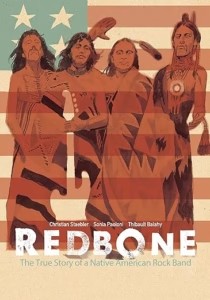Redbone: The True Story of a Native American Rock Band
Christian Staebler and Sonia Paoloni
Illustrated by Thibault Balahy
IDW
Published October 28, 2020
Amazon | Bookshop | Goodreads
About book
Experience the riveting, powerful story of the Native American civil rights movement and the resulting struggle for identity told through the high-flying career of West Coast rock ‘n’ roll pioneers Redbone.
You’ve heard the hit song “Come and Get Your Love” in the movie Guardians of the Galaxy, but the story of the band behind it is one of cultural, political, and social importance.
Brothers Pat and Lolly Vegas were talented Native American rock musicians that took the 1960s Sunset Strip by storm. They influenced The Doors and jammed with Jimmy Hendrix before he was “Jimi,” and the idea of a band made up of all Native Americans soon followed. Determined to control their creative vision and maintain their cultural identity, they eventually signed a deal with Epic Records in 1969. But as the American Indian Movement gained momentum the band took a stand, choosing pride in their ancestry over continued commercial reward.
Created in cooperation of the Vegas family, authors Christian Staebler and Sonia Paoloni with artist Thibault Balahy take painstaking steps to ensure the historical accuracy of this important and often overlooked story of America’s past. Part biography and part research journalism, Redbone tells a vivid story about this neglected chapter of American history.
My Review
Reading this book was a spur-of-the-moment decision, but I’m so glad I did. The title and subtitle caught my eye. I hadn’t heard of Redbone, and the history surrounding this Native American rock band intrigued me.
The foreward gives some context, and I knew reading it that I would enjoy the book. The author’s enthusiasm for the band is infectious.
The book begins with a present-day scene that leads to an interview with Redbone band member Pat Vegas. From there, the narrative flashes back, showing scenes from the 1960s and 1970s. The scenes depict events in the lives of the band members.
To be honest, I have a LOT of catching up to do about Native American history in the US. This book helped identify some of the holes that still remain in my understanding. The text mentions Indian Boarding Schools (one band member grew up in one of these) which were in effect in some places until the 1970s. We think of these things as having happened so long ago, and that’s… really not so long ago.
I was also unfamiliar with the protest at Wounded Knee and its connection to Standing Rock. The book briefly explains the connection and the band’s decision to support the protest. I loved learning about Redbone’s history and especially the ways they stood up for Indigenous people.
This is a really fun book to read and a pretty quick one as well. There are a few pages with a lot of dialogue in one panel that were a little bit confusing at first. Overall, this is really well done. I think music fans and readers interested in learning more about Indigenous history will find lots to love in this book.
“We Were All Wounded at Wounded Knee”
The book talks about a song that the band wrote in support of the protest at Wounded Knee. Here is a link to a video of the song called “We Were All Wounded at Wounded Knee.”
Content Notes
Recommended for Ages 12 up.
Profanity/Crude Language Content
None.
Romance/Sexual Content
Brief, vague reference that someone had sex. Nothing on scene.
Spiritual Content
None.
Violent Content
Reference to Indian Boarding Schools and the harm they caused. Reference to the battle at Wounded Knee. (Battle not shown.) References to racism against BIPOC, particularly Indigenous people.
Drug Content
Adult characters visit a bar and perform at nightclubs.
Note: This post contains affiliate links, which do not cost you anything to use but help support this blog. All opinions are my own.
